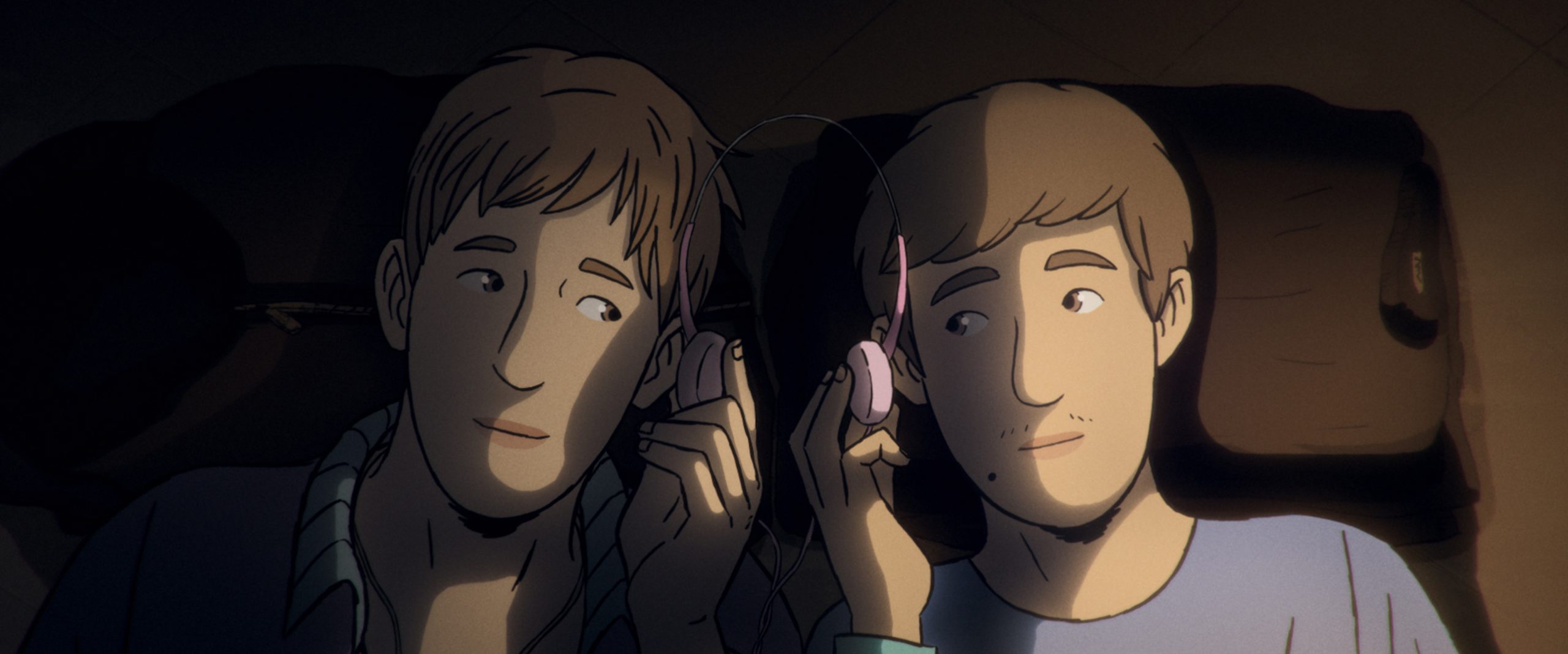
Interview with Jonas Poher Rasmussen
By Lars Henriksen
“I would like us to have an eye-level conversation where we are not talking about systems but talking about the people we are surrounded by and their conditions.”
It’s a cold day at the end of February when Jonas Poher Rasmussen and I finally manage to find a time to meet and talk about his Oscar-nominated film Flee. Jonas, who is preparing to spend the next month in Los Angeles to promote the film ahead of the film Academy’s final decision at the Dolby Theatre on 27 March, arrives by bike from a meeting in Nyboder. By the time this issue of HeartCore is out, we will know the outcome.
How do you and Amin know each other?
We went to high school together, that is, we lived in the same small town – he arrived as an unaccompanied refugee child when I was 15 and he was 16, I believe, and lived with a foster family. Ever since we met, I was curious about how and why he suddenly showed up in my hometown, but he did not want to tell me. Most of all because he didn’t want to lie, because then he would have to tell this fake story. He always just said, “I don’t want to talk about it.” Of course, I respected that. 15 years ago, I asked if I could do a radio broadcast about his story, and he replied that he knew he had to tell his story at some point, but he wasn’t quite ready yet. We had an agreement that it was something we would do together when he felt ready. Several people have reached out to him, but he wanted to tell someone he was comfortable with.
It’s one thing to be ready to tell you. It’s another thing to be ready to tell the whole world. How does the next step become, “are we going to make a movie”?
Well, we’re so close that it’s been a very open talk – he knew that I was curious and that I wanted to do something with him, and then I was invited to a workshop called Amdocs, where they invite documentarians and animators to develop ideas for animated documentaries. Then I asked him if he’d want to share his story, and this – the idea that he could remain anonymous behind the animation – was really what made him feel comfortable opening up. Because he didn’t have to be public with his story – he could share it with the world without having his face plastered on it, so he can still meet people without them knowing it’s him, and without having to small-talk about things that are really hard for him to talk about. That’s what made him say, “OK, this actually feels like a way where I can see myself in it.”
What’s the advantage of telling the story as an animated narrative?
I think there’s something about animation that opens us up. Especially because of news stories – we’re constantly met with so many of these types of stories and seeing a human face that suffers, it’s hard to take in, because if you take it all in, then you won’t be able to get up in the morning. When the film is animated, I think you have your walls down a bit more and maybe you start to listen more. I also have a slightly home-knit theory that because we’ve grown up with animation as the medium we see when we’re children, we’re a little more open and there is a slightly more direct path to the heart. Then I was randomly invited to this workshop, and then it could suddenly be done – because he could be anonymous, but also because it’s a story that is partly set in the past and it was important to bring the past back to life, and animation is a really good tool to do so.
It seems like there’s almost a therapeutic element to the film; the consideration of having to stay in the city, or move to the countryside, about leaving your partner and how much to invest in the relationship versus the career, etc. and where Amin in fact exposes another side of himself.
Yes completely, and, in any case, it’s my postulate that the escape he’s been on has continued inside him, and he’s had difficulty settling down and being calm, because he’s always felt that he should hide from himself and has had a need to stay away from people, because he was afraid to expose himself. So, it’s true that the process of releasing his story – to unburden himself, to get rid of it, it’s of course been therapeutic for him. He said it already in the first interview that, “this, this is going to be therapeutic for me.”
It’s also an interview technique I learned when doing radio called moment interviews, which focuses on – since you don’t have a picture – making your interview victim be hugely descriptive by making them lie down and having them close their eyes, and have them describe the location that they are in and come up with a lot of details, which of course gives the animator a lot to work with, but it also allowed Amin to enter into the specific memory and talk in a much more present way, and memories that he might otherwise have forgotten comes to light. It’s really a way to create presence and recognize sounds and smells and relive these memories rather than just retell them. You can feel it in the voice.
There is, I think, such a magical moment, which also surprises you a little, at the very end of the film, where the animation shifts to the “real” image and you sit and think, “hey, has it all been drawn over real pictures?” It breaks down the line between the animated and the reality. How have you and the animator worked together to recreate these images that you haven’t seen in real life?
Everything that goes on in the present, we recorded on video, but everything in the past is partly based on the things that Amin told us, and we did a lot of research, found archival material, photos, and tried to make the animation look like Kabul in the 1980s. We had to find a lot of material and be quite specific. We knew where he lived in Kabul and tried to find some photo material from that area.
It was hard, because people didn’t have smartphones back then, so we’d to go to the library and borrow books and find some pictures. But we found archive material and then we could take it directly and draw it and put it into the animation.
Amin hasn’t been very involved in the pictures and the visuals, but primarily on the script level. It’s a story that takes place over 30 years, so there’s a lot of material that didn’t make it in. He read the things I chose and made comments if there was something that was factually wrong, or if I’d taken out things that he thought were really important. Or if there were things he wanted to take out. He was a little embarrassed by the scene where he asks for medication against being gay. That, he thought, was hugely embarrassing, but for me it was hugely telling. It says something about where you come from, and the shame you carry with you, and about coming from a place where there’s no neutral word for being gay and you carry this with you – to Denmark and a completely different system. So, it was always a dialogue back and forth about what should be included in this story for him to feel represented and for it to be an honest film.
Do you consider Flee an activist movie?
No, that wasn’t the idea. It was born out of my fundamental curiosity about my friend. For me, it was a friendship story, which was also an escape story, and which was also a queer story, but at the heart of it is our friendship, and the fact that in our friendship always there has been this black box that you couldn’t open.
Would it take anything away from the film if you become part of a political debate you think?
I think so. Because it’d be a conversation about systems at the expense of the human experience, and I’m not really interested in that. I want to focus on human history. And once you get into it and become part of all these shouting voices, then the fight is already lost, because then you’ll not convince anyone of anything.
And maybe the way to break down systems is to put faces on people?
That, I think, is clearly the way to do it, because a big part of the reason for the situation we’re in now is the way we talk. Both politicians and the media. The systems are built on the way we talk. When the rhetoric gets tough, the systems get tough. So, I would like to try to go the other way. I would like us to have an eye-level conversation, where we aren’t talking about systems but talking about the people we’re surrounded by and their conditions.
Now you’re nominated for three Oscars. That’s pretty crazy!
It is absolutely insane!
Do you have a favorite category?
I would say, I accept all three of them.
But also the heart of the film is Amin’s story, which is a documentary story. So somehow it mostly belongs in the documentary category, because while animation is the form, and it’s great if it’s also rewarded for it, it is just form. And then there’s an international category, which is such a strange thing, where you put everything in, and that’s … It’s a documentary!
When did you know – if there was a time or a moment – that you had made an Oscar-worthy movie?
In the production, when we were finishing, I had such a feeling that we had made something special. Whether it would be Oscar-worthy, I don’t think we thought about that at the time. But after its premiere at Sundance, where it won the main prize in its category and we sold it to a major American distributor just afterwards who had a very pronounced plan that they would like it to be nominated for 3 Oscars …
They simply said that?
That’s what they said at the first meeting. “We believe this movie can win three Oscars.”
Is Amin going to Los Angeles?
No, I don’t think so.
Can he stand to sit here at home?
I actually think he would find it a lot of fun, and especially Kasper [Amin’s partner, ed.] would think it was really funny, but I don’t think that’s going to happen. There’s so much press and it’s going to be really hard to keep anonymity, so – if they were going, I wouldn’t tell anyone.
INFO
Flee is an animated documentary about Amin (not his real name) who, at 16, comes to Denmark as an unaccompanied refugee child after a years-long flight. It is also the story of finding oneself as partner, gay, and human with a traumatic baggage. The film is Jonas Poher Rasmussen’s eighth film. The 2015 film What He Did about Jens Michael Schau also has a gay protagonist. Flee is nominated for an Oscar in three categories: Best Animated Film, Best Documentary and Best International Film. While it did not win in any of the category, it made history by being the first Danish movie to receive three nominations.



